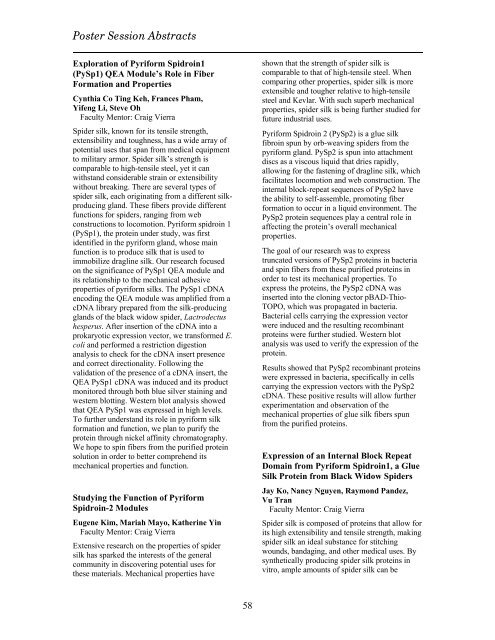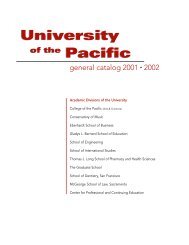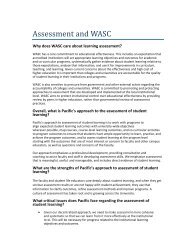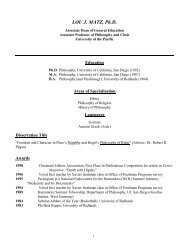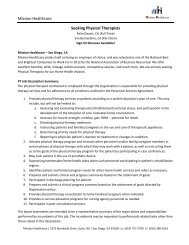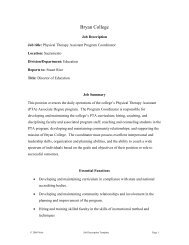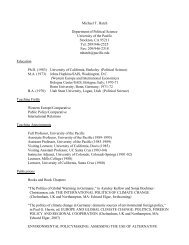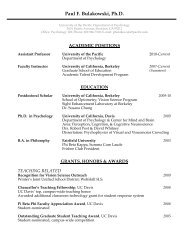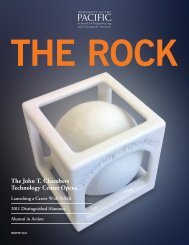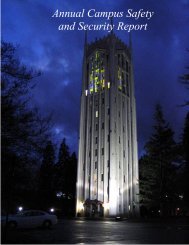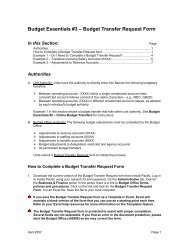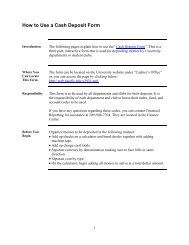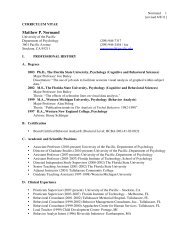purcc 2012 - University of the Pacific
purcc 2012 - University of the Pacific
purcc 2012 - University of the Pacific
You also want an ePaper? Increase the reach of your titles
YUMPU automatically turns print PDFs into web optimized ePapers that Google loves.
Poster Session Abstracts<br />
Exploration <strong>of</strong> Pyriform Spidroin1<br />
(PySp1) QEA Module’s Role in Fiber<br />
Formation and Properties<br />
Cynthia Co Ting Keh, Frances Pham,<br />
Yifeng Li, Steve Oh<br />
Faculty Mentor: Craig Vierra<br />
Spider silk, known for its tensile strength,<br />
extensibility and toughness, has a wide array <strong>of</strong><br />
potential uses that span from medical equipment<br />
to military armor. Spider silk’s strength is<br />
comparable to high-tensile steel, yet it can<br />
withstand considerable strain or extensibility<br />
without breaking. There are several types <strong>of</strong><br />
spider silk, each originating from a different silkproducing<br />
gland. These fibers provide different<br />
functions for spiders, ranging from web<br />
constructions to locomotion. Pyriform spidroin 1<br />
(PySp1), <strong>the</strong> protein under study, was first<br />
identified in <strong>the</strong> pyriform gland, whose main<br />
function is to produce silk that is used to<br />
immobilize dragline silk. Our research focused<br />
on <strong>the</strong> significance <strong>of</strong> PySp1 QEA module and<br />
its relationship to <strong>the</strong> mechanical adhesive<br />
properties <strong>of</strong> pyriform silks. The PySp1 cDNA<br />
encoding <strong>the</strong> QEA module was amplified from a<br />
cDNA library prepared from <strong>the</strong> silk-producing<br />
glands <strong>of</strong> <strong>the</strong> black widow spider, Lactrodectus<br />
hesperus. After insertion <strong>of</strong> <strong>the</strong> cDNA into a<br />
prokaryotic expression vector, we transformed E.<br />
coli and performed a restriction digestion<br />
analysis to check for <strong>the</strong> cDNA insert presence<br />
and correct directionality. Following <strong>the</strong><br />
validation <strong>of</strong> <strong>the</strong> presence <strong>of</strong> a cDNA insert, <strong>the</strong><br />
QEA PySp1 cDNA was induced and its product<br />
monitored through both blue silver staining and<br />
western blotting. Western blot analysis showed<br />
that QEA PySp1 was expressed in high levels.<br />
To fur<strong>the</strong>r understand its role in pyriform silk<br />
formation and function, we plan to purify <strong>the</strong><br />
protein through nickel affinity chromatography.<br />
We hope to spin fibers from <strong>the</strong> purified protein<br />
solution in order to better comprehend its<br />
mechanical properties and function.<br />
Studying <strong>the</strong> Function <strong>of</strong> Pyriform<br />
Spidroin-2 Modules<br />
Eugene Kim, Mariah Mayo, Ka<strong>the</strong>rine Yin<br />
Faculty Mentor: Craig Vierra<br />
Extensive research on <strong>the</strong> properties <strong>of</strong> spider<br />
silk has sparked <strong>the</strong> interests <strong>of</strong> <strong>the</strong> general<br />
community in discovering potential uses for<br />
<strong>the</strong>se materials. Mechanical properties have<br />
shown that <strong>the</strong> strength <strong>of</strong> spider silk is<br />
comparable to that <strong>of</strong> high-tensile steel. When<br />
comparing o<strong>the</strong>r properties, spider silk is more<br />
extensible and tougher relative to high-tensile<br />
steel and Kevlar. With such superb mechanical<br />
properties, spider silk is being fur<strong>the</strong>r studied for<br />
future industrial uses.<br />
Pyriform Spidroin 2 (PySp2) is a glue silk<br />
fibroin spun by orb-weaving spiders from <strong>the</strong><br />
pyriform gland. PySp2 is spun into attachment<br />
discs as a viscous liquid that dries rapidly,<br />
allowing for <strong>the</strong> fastening <strong>of</strong> dragline silk, which<br />
facilitates locomotion and web construction. The<br />
internal block-repeat sequences <strong>of</strong> PySp2 have<br />
<strong>the</strong> ability to self-assemble, promoting fiber<br />
formation to occur in a liquid environment. The<br />
PySp2 protein sequences play a central role in<br />
affecting <strong>the</strong> protein’s overall mechanical<br />
properties.<br />
The goal <strong>of</strong> our research was to express<br />
truncated versions <strong>of</strong> PySp2 proteins in bacteria<br />
and spin fibers from <strong>the</strong>se purified proteins in<br />
order to test its mechanical properties. To<br />
express <strong>the</strong> proteins, <strong>the</strong> PySp2 cDNA was<br />
inserted into <strong>the</strong> cloning vector pBAD-Thio-<br />
TOPO, which was propagated in bacteria.<br />
Bacterial cells carrying <strong>the</strong> expression vector<br />
were induced and <strong>the</strong> resulting recombinant<br />
proteins were fur<strong>the</strong>r studied. Western blot<br />
analysis was used to verify <strong>the</strong> expression <strong>of</strong> <strong>the</strong><br />
protein.<br />
Results showed that PySp2 recombinant proteins<br />
were expressed in bacteria, specifically in cells<br />
carrying <strong>the</strong> expression vectors with <strong>the</strong> PySp2<br />
cDNA. These positive results will allow fur<strong>the</strong>r<br />
experimentation and observation <strong>of</strong> <strong>the</strong><br />
mechanical properties <strong>of</strong> glue silk fibers spun<br />
from <strong>the</strong> purified proteins.<br />
Expression <strong>of</strong> an Internal Block Repeat<br />
Domain from Pyriform Spidroin1, a Glue<br />
Silk Protein from Black Widow Spiders<br />
Jay Ko, Nancy Nguyen, Raymond Pandez,<br />
Vu Tran<br />
Faculty Mentor: Craig Vierra<br />
Spider silk is composed <strong>of</strong> proteins that allow for<br />
its high extensibility and tensile strength, making<br />
spider silk an ideal substance for stitching<br />
wounds, bandaging, and o<strong>the</strong>r medical uses. By<br />
syn<strong>the</strong>tically producing spider silk proteins in<br />
vitro, ample amounts <strong>of</strong> spider silk can be<br />
58


